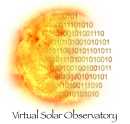Observable
It is in the description of the independent variables, what the data in fact measure, that there is the greatest variation in terminology among data archives. Most solar observational data consist of direct measurements of the intensity of radiation as a function of time, direction (location), wavelength, and polarization, or combinations of intensities associated with different independent variables (e.g. line shifts and splittings, Stokes parameters). These data may be interpreted as measurements of certain physical observables, such as temperature, velocity, emission measure, etc. via models. There are of course some important exceptions: some solar data archives include in situ measurements of such observables as particle fluxes and compositions and magnetic field strengths; some solar data sets represent not direct observation but the results of complex inversions or modeling, such as the frequencies of acoustic modes, or the interior structure; and there are catalogs, histories, and descriptions of features and events. As long as the various observable classes are orthogonal, however, these additional cases should present no problem.
The model of describing observables in terms of particular combinations of intensity measurements or the associated physical parameters to be derived from them is a natural one for data deriving from imaging spectrographs, such as magnetographs and helioseismic instruments. For cameras or radiometers measuring only intensity or flux at selected wavelengths, it is not so natural. People dealing with data from such instruments tend to think of the observables as being associated with the spectral wavelength or band selected, or for monochromatic instruments, even the spatial-temporal target of the observations. It is important to understand that the meaning of the term "observable" in the VSO Search Parameter model may not at all agree with the meaning of the term as used by the data providers.
Physical_Observable
type: menu
FITS keyword: PHYS_OBS
The following values are currently recognized:
intensity
the direct intensity, either integrated over the spectral observing range or as a function of wavelength (spectral density)
equivalent_width
differences between intensities measured at nerbay wavelengths, typically in line cores, wings, and nearby continuum, whether measured as an intensity difference or an equivalent width
polarization_vector
the net linear polarization
LOS_magnetic_field
the frequency/wavelength Zeeman splitting between opposite circular polarizations of a magnetically-sensitive line
vector_magnetic_field
field strengths and directions inferred from Stokes polarimetry
LOS_velocity
the displacement of line center from rest wavelength/frequency in an arbitrary polarization state
vector_velocity
two- or three-dimesnional velocities, typically inferred from helioseismic inversion or from directly measured velocities transverse to the line of sight, possibly combined with Doppler velocities
wave_power
wave_phase
oscillation_mode_parameters
These all refer to solar internal or atmospheric acoustic-gravity wave measurements. The mode parameters could include frequencies, splittings, amplitudes, widths, etc.
number_density
particle_flux
composition
particle_velocity
thermal_velocity
in-situ observations
In addition to the above, the following classes have been suggested:
- Electric Field Strength - the Stark effect splitting
- Transverse Magnetic Field Strength - Hanle effect measurements
- Stokes Parameters (I, Q, U, V - equivalent to observables of net circular, linear and total polarization, and polarization angle
- in situ Magnetic Field
- Differential Emission Measure
- Model Parameters - Interior, Atmosphere, Solar Wind
